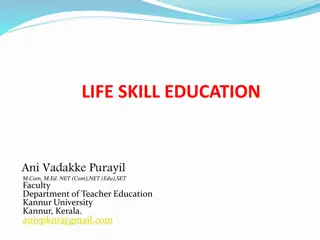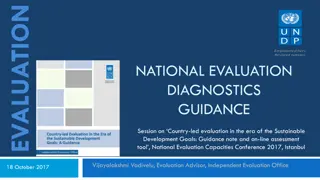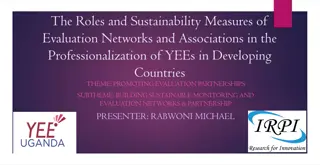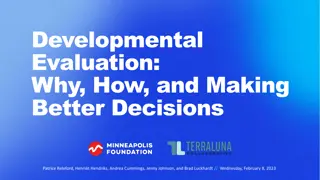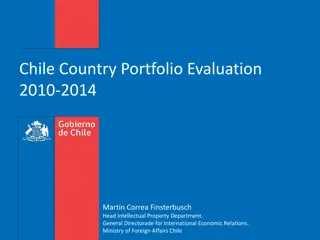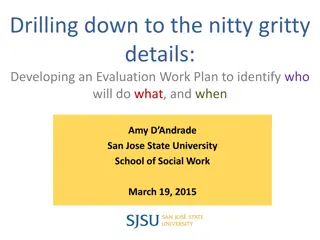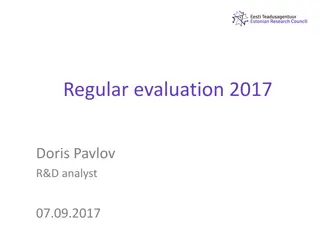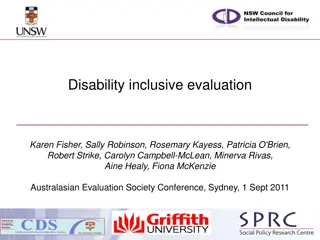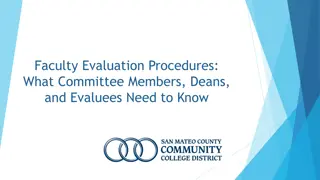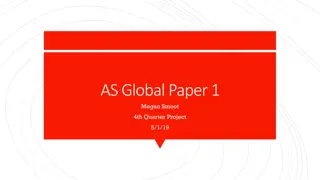Enhancing Information Evaluation and Presentation Skills
Explore the significance of information evaluation and effective presentation techniques for authors and audience engagement. Consider potential biases, establish author credentials, and present ideas clearly to enhance communication. Learn to evaluate information quality for effective use in academic and professional settings.
Download Presentation

Please find below an Image/Link to download the presentation.
The content on the website is provided AS IS for your information and personal use only. It may not be sold, licensed, or shared on other websites without obtaining consent from the author.If you encounter any issues during the download, it is possible that the publisher has removed the file from their server.
You are allowed to download the files provided on this website for personal or commercial use, subject to the condition that they are used lawfully. All files are the property of their respective owners.
The content on the website is provided AS IS for your information and personal use only. It may not be sold, licensed, or shared on other websites without obtaining consent from the author.
E N D
Presentation Transcript
This presentation is best viewed in Slide Show mode Read and think at your own speed by clicking on the Enter key to see each new point
Do writing, formatting, referencing, etc facilitate communication? Evaluate the quality & relevance of information before you use it You: the information user Information Evaluation You: the information creator Evaluate the quality of information that you have created before you submit it Are ideas & arguments presented clearly? By Sandra Cochrane (Engineering & Surveying Librarian)
This resource: Introduces criteria for information evaluation Applies the evaluation criteria to you (as an author) and the information source that you are creating (through your poster) Q Q Applies the evaluation criteria to a journal article about sustainability to help you learn how to evaluate information to ensure that it s worth using
A. Be aware of YOU and YOUR potential bias: We (as people) tend to seek information in places where we expect to find the information that confirms our existing views Unless we make special efforts to open our minds to alternative points of view, we tend to maintain our existing views no matter how much evidence to the contrary is presented to us Is there anything that you can do with your poster to Q Q make it as appealing as possible, and increase the chances of opening peoples minds to your messages/s?
B. Establish credentials or expertise of author/s To give your audience confidence in your work Make your authorship clear to your audience Provide your credentials (don t under-value your student status saying that you are an undergraduate Urban and Regional Planning student tells your audience a lot when they are judging the value of your work) What formatting options are best to Q Q demonstrate your ownership of the work and to let your audience easily see your credentials?
C. Ideas & arguments should be developed & presented logically & clearly Clearly articulating the purpose of your poster allows your audience to decide whether it is relevant to them Thoughtful use of images, diagrams and tables complements your text and expresses your work concisely Emotive language can make your audience suspicious of your intentions. Objective language allows the audience to critically analyse your work and demonstrates your professionalism Poster formatting helps your reader follow your rationale, and understand your message How do all of these presentation factors influence Q Q your poster planning, and have you been realistic about the amount of time it will take to address the presentation issues?
D. Quality of evidence presented: Your audience will be looking for information that is up-to-date (current) According to the assignment instructions, your poster has to describe or explain or identify specified elements Description, explanation and identification are different kinds and levels of information. Your audience will be expecting to see the appropriate information level applied to the appropriate element, and will judge the quality of your presentation and professionalism accordingly The information that you present should be based on sound sources of evidence rather than your opinion. In professional practice, objectivity is paramount and professional opinion should always be backed up with evidence Have you addressed all of the elements Q Q comprehensively yet concisely, and to the appropriate level?
E. Quantity of evidence presented To promote your position, your poster needs to present the right amount of information Your poster should not present too much information as this will detract from its visual appeal and, as a result, your ability to communicate through it How will you ensure that you create a solid and Q Q credible source of information for your audience whilst maintaining visual appeal?
F. Presentation mechanics Mistakes in grammar and spelling make information difficult to understand and apply to professional situations Complete and accurate referencing allows your audience to judge the sources of information on which you have relied Text size, dot points, images, tables, diagrams and colour schemes all influence the readability of your poster Do your spelling, grammar and formatting Q Q promote the communication of your message, and your professionalism?
Applying criteria to information that you wish to use: Your poster is an information source for someone else but, what if you want You apply the to use someone else s information to very same help you develop your knowledge base? criteria to the work that you are considering To see how to evaluate someone else s using work, read this article and then see to build your how the evaluation criteria knowledge base has been applied One more slide to go
These criteria have been adapted from: Flateby, T., & Fehr, R. (2008). Assessing and improving writing in the engineering curriculum. International Journal of Engineering Education, 24(5), 901-905. Retrieved from http://www.ijee.dit.ie Reference for article that we evaluated: Scoones, I. (2007). Sustainability. Development in Practice, 17(4-5), 589-596. doi: 10.1080/09614520701469609 Handout version of this PowerPoint presentation (in pdf) Article to which evaluation criteria is applied & application of evaluation criteria to a journal article (both in pdf) Evaluation criteria template for you to use in the future (in Word) If you re not sure how to describe, explain or identify, check out The Learning Centre s online help Analysing the question More poster presentation help available on the Planning Pages






